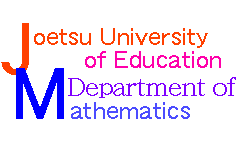
Welcome to NUNOKAWA's Homepage
[Japanese version]
Kazuhiko Nunokawa

(Mathematics Education)
by Miyuki MURANAKA 
Martian Version
Meditation Version
Onion Version
Portraits by 3rd-graders of our attached school
I am interested in human's thinking processes in mathematical problem solving, and their relations to the nature of mathematical knowledge. Maybe, the human is a being that cannot help making sense of the world and mathematical knowledge is one of various materials used to do that.
Recent Publications
Previous publications can be found here
- Nunokawa, K. (1998). Empirical and autonomical aspects of school mathematics. Tsukuba Journal ofEducational Study in Mathematics, 17, 205-217.
 (41K)
(41K)
- Nunokawa, K. (1997). Giving new senses to the existing elements: A characteristic of the solutionaccompanied by global restructuring. Journal of Mathematical Behavior, 16 (4), 365-378.
- Nunokawa, K. (1997). Physical models in mathematical problem solving: A case of a tetrahedron problem. International Journal of Mathematical Education in Science andTechnology, 28 (6), 871-882.
- Nunokawa, K. (1997). Microanalysis of the ways of using simpler problems in mathematical problem solving.Å@Proceedigns of the 21st Conference of the International Group for the Psychology of Mathematics Education (Vol. 3, pp. 296-303). Lahti, Finland.
 (48K)
(48K)
- Nunokawa, K. (1997). Data versus conjectures in mathematical problem solving. Focus on Learning Problems in Mathematics, 19 (1), 1-19.
- Nunokawa, K. (1996). Applying Lakatos' theory to the theory of mathematical problem solving. Educational Studies in Mathematics, 31 (3), 269-293.
- Nunokawa, K. (1996). A continuity of solver's structures: Earlier activitiesfacilitating the generation of basic ideas. Tsukuba Journal ofEducational Study in Mathematics, 15, 113-122.
- Nunokawa, K. (1995). Problem solving as modelling: A case of augmented-quotientdivision problem. International Journal of Mathematical Education in Science andTechnology, 26 (5), 721-727.
- Nunokawa, K. (1994). Solver's structures of a problem situation and their globalrestructuring. Journal of Mathematical Behavior, 13 (3), 275-297.
- Nunokawa, K. (1994). Improving diagrams gradually: One approach to using diagramsin problem solving. For the Learning of Mathematics, 14 (1), 34-38.
- Nunokawa, K. (1994). Naturally GeneratedElements and Giving Them Senses: A Usage of Diagrams in Problem Solving.In J. P. Ponte & J. F. Matos (Eds.), Proceedings of the 18th International Conferencefor the Psychology of Mathematics Education, vol. III (pp.376-383). Lisbon: Universityof Lisbon.
- Nunokawa, K. (1994). Solvers' Spontaneous Balancing of the Level of Difficulty in Mathematical Problem Solving. Tsukuba Journal ofEducational Study in Mathematics, 12 (B), 47-56.
In Press
- Nunokawa, K. (in press). Heuristic Strategies and Probing Problem Situations. In Jose Carrillo & Luis C. Contreras (Eds.), Problem-soling in the beginning of the 21st century: An international overview from
multiple perspectives and educational levels. Servicio de Publicaciones, Universidad de Huelva.
Please let me know your impression about this page and imformation about math education:nunokawa@juen.ac.jp



